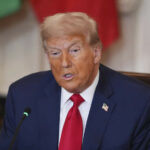Traders betting that Donald Trump would defeat Kamala Harris in the closely contested US presidential election sent the dollar to its highest level since July, also pushing up 10-year US Treasury yields.
With several key states still undecided, the 10-year yield advanced above 4.34 per cent on Tuesday evening after falling to 4.25 per cent earlier in the day, according to data from Bloomberg.
“The early trades are favouring Trump,” said Andrew Brenner, head of international fixed income at NatAlliance.
The Mexican peso, which often suffers when Trump is perceived as doing well, weakened to about 20.38 against the US dollar, a fresh two-year low. The Japanese yen fell by about 1.3 per cent after early polls closed, dropping to about 153 against the US dollar, its lowest in nearly a week.
The dollar, which earlier on Tuesday hit a two-week low against a basket of currencies, jumped to more than recoup its losses as jitters reverberated across markets and investors fretted over the election’s implications.
Bitcoin, considered a “Trump trade” on the belief that the former president would regulate cryptocurrencies lightly if elected, rose above $75,000 to hit an all-time high.
US stocks earlier ended Tuesday’s election day session with their strongest gains in six weeks as anxious investors awaited the results of an election that is expected to affect markets around the world. The S&P 500 closed the day 1.2 per cent higher — its best performance since mid-September — while the tech-heavy Nasdaq Composite gained 1.4 per cent.
“The good news is that the wait for the US election is over, the bad news is that it will be a long night for volatility,” said Bob Savage, head of markets strategy and insights at BNY, who described Tuesday’s mood as “risk on . . . but timidly given the too-close-to-call uncertainty”.
Stuart Kaiser, head of equity trading strategy at Citi, said on Tuesday evening that while markets appeared to be pricing in increased odds of a Trump win, there was “a lot of information still to come”, such as the outcome of swing states including Pennsylvania.
“People are going to have to either hedge or express views through those futures, and then when the markets open in the morning, we’ll be able to see the more nuanced trades,” Kaiser said.
Most emblematic of the swings that characterised Tuesday’s action was Donald Trump’s social media group, Trump Media & Technology. Shares rose as much as 15 per cent before a sudden plunge briefly halted trading. They ended down 1.1 per cent.
“There is a hyped-up sense of anticipation as we await the results,” said Mark Dowding, chief investment officer at RBC BlueBay Asset Management. “We all know how much is at stake on this election outcome, but until the polls close we won’t know which way to jump.”
Wall Street has been preparing for a long night, pausing software updates and booking hotel rooms for suburb-dwelling traders among other logistics.
Ed Al-Hussainy, a senior rates analyst at Columbia Threadneedle, said his team had a bigger than usual cash stockpile to put to work as opportunities became apparent in the markets.
“No one wants to stick their necks out,” Al-Hussainy said, adding that he expected a race among investors to add risk once election outcomes are more certain. “If you’re behind your peers, you basically get worse prices. Stuff gets rich pretty quickly.”
Investors are anxious that may be little clarity on the election result before critical interest rate-setting decisions are due from both the Federal Reserve and the Bank of England due on Thursday.
William Vaughan, associate portfolio manager at Brandywine Global Investment Management, said the potential for an unclear election result by the time of the Fed meeting contributed “significant uncertainty”, highlighting the four-day wait until the Associated Press made its call on the winner of the 2020 election.
The Ice BofA Move index, a keenly watched gauge of investors’ expectations of future volatility in US Treasuries, on Monday hit its highest in more than a year as a mixture of political and interest rate uncertainty unsettled the $27tn market.
Analysts at UBS said levels implied by options on the S&P 500 index suggested the benchmark could swing sharply at the end of the week. The cost of buying protection against moves in exchange rates such as euro-dollar has also jumped.
The Vix index, Wall Street’s so-called fear gauge, dropped to about 20.5 after rising as high as 23.4 late last week. Tuesday’s positive equity market returns likely contributed to the decrease in implied near-term volatility, said Matt Orton, chief market strategist at Raymond James Investment Management.
“I would expect to see that come in fairly significantly,” Orton said, adding that he was “very optimistic of where is market can go once the noise starts to settle”.
The knife-edge election has been viewed as a potential watershed moment by investors. If Republicans were to win the White House and both houses of Congress, investors worry that Trump’s promised mixture of tariffs and tax cuts could feed inflation and put upward pressure on interest rates.
That had led to a rally in the dollar and a rise in longer-dated Treasury yields in recent weeks.





